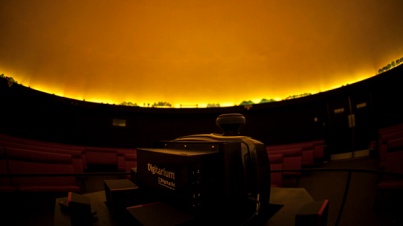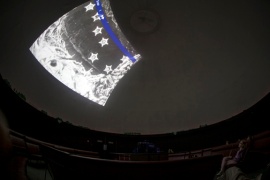Ogden News
WKU’s Hardin Planetarium adds digital projection system
- Friday, April 12th, 2013
A new digital projection system at the Hardin Planetarium may not take audiences to infinity and beyond but “it does take us places we were never able to see before,” according to WKU astronomy professor Richard Gelderman.
“This system can take you anywhere a computer programmer’s imagination can go,” Dr. Gelderman said.

The Hardin Planetarium’s new digital projection system was installed in late December. (WKU photo by Bryan Lemon)
The Digitarium system, purchased from Digitalis Education Solutions in Bremerton, Wash., arrived in late December and replaced the original star projector installed at the Hardin Planetarium in 1967.
“The new projector provides three new features,” Dr. Gelderman said. “It is immersive, which means it’s all around you and you’re in the middle. It is 360 degrees, which means it wraps around you. And it is full-dome, which means it’s over the top as well as all around you.”
Since late December, Dr. Gelderman and Planetarium Coordinator Ronn Kistler have tested the new system’s capabilities and have added interactive features to engage the audience.
“If you come to a show, you will be encouraged to participate and engage yourself in what’s going on around you,” Dr. Gelderman said.
The latest show, Curiosity: Drilling into Mars’ Past, is launched with a trip through the solar system and then to the inner planets around the Sun. “It’s a view of the solar system we never could have done before,” Dr. Gelderman said. “It’s a pretty incredible experience.”

In addition to using a digital projector, staff at the Hardin Planetarium have added interactive features to engage the audience in planetarium shows. (WKU photo by Bryan Lemon)
During a reception on April 10, Dr. Gelderman, Kistler and student worker Tyler Scaff demonstrated the new system’s capabilities with both a brief interactive constellation show and a special showing of Origins of Life. Among those participating were WKU President Gary Ransdell, Ogden College of Science and Engineering Dean Cheryl Stevens and several other Ogden College faculty and staff members.
Dr. Keith Andrew, head of the Department of Physics & Astronomy, offered this review of the show: “It was well WOW. The new digital projector adds a new dimension to the capabilities of the planetarium, a vast archive of digital data, everything from stars, planets, constellations, galaxies, black holes and cosmology using data from places such as the Hubble Space Telescope to a wide range of scientific and engaging learning environments using digital delivery of video that includes dinosaurs, planet formation, continental drift, DNA replication and the evolution of life as shown here today,” Dr. Andrew said. “I expect in the next few years a multitude of new and educationally engaging STEM-based learning activities for students and the community — as in the Spring Break Camp of last week — will be developed to immerse participants in a new learning process. It looks great to me. Did I say WOW?”
The Hardin Planetarium, which opened in 1967, is located at State Street and College Heights Boulevard on the WKU campus. Free public shows are offered each week at 7 p.m. on Tuesdays and Thursday or at 2 p.m. on Sundays. For information, contact the planetarium at (270) 745-4044 or visit http://www.wku.edu/hardinplanetarium/.
Contact: Ronn Kistler or Richard Gelderman, (270) 745-4044.

